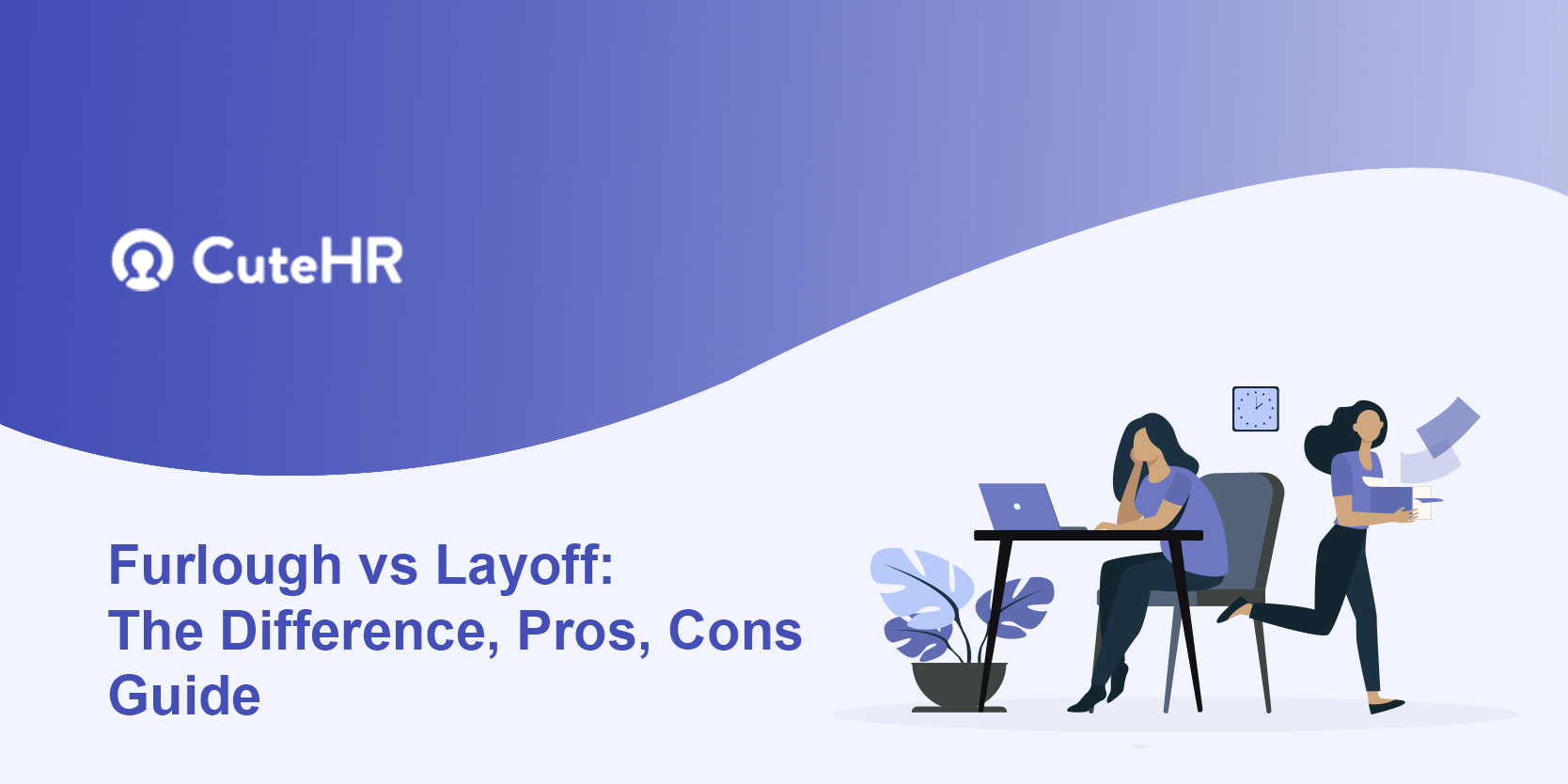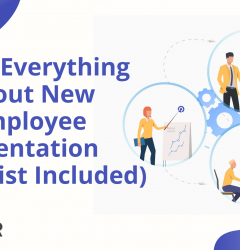25 Feb

Are furloughs and layoffs the same thing? Well, both furloughs and layoffs are very common among businesses that are looking forward to reducing their staff count in response to a lack of work or funds. But what’s the difference between furloughs vs layoffs?
Furloughs and layoffs may show resemblance, and many consider them to be the same thing, but the requirements and the outcome are very different. In this article, we will have a detailed comparison of furloughs vs layoffs and provide all the necessary information regarding these two processes.
Table of Contents
What Is Layoff?
A layoff is usually adopted by a company to cut costs quickly. Since a major chunk of the company’s budget is utilized for employee salary and benefits, layoffs are very effective to reduce the company’s expenses by a considerable margin.

Layoffs can be both temporary or permanent, depending on the company’s cost reduction target. There are many people who confuse layoffs with a reduction in force. A reduction in force is basically when an employee is laid off from a job permanently, and that particular position is terminated forever. In comparison, a layoff is just a regular employee termination where the company serves tiers with the employee.
In case if the layoff is permanent, some companies do provide severance packages, opportunities to apply for another position in a company, or may provide new job search assistance.
Some industries like seasonal workforces ( such as restaurants, summer camp organisations, and ski resorts) deliberately lay off their employees with the motive to rehire them in the following season. This may be considered as a temporary layoff and usually lasts for about six months. Even though the decision of rehiring is dependent on the employer, the employees must understand that rehiring is not guaranteed.
What Are The Employee’s Rights When They’re Laid Off?
Typically, the employer is required to give the employee a 30-days notice before laying them off. A temporary layoff typically lasts for not more than 6 months. The employer needs to compulsorily submit a 30-days notice in the case where:
- The company has 100 or more full-time employees with at least six months on the job; or
- Employs 100 or more staff that work at least a combined 4000 hours a week
If your company provides you with a severance package, it should not be accepted since it may give up some of your rights. For instance, you may have to agree to a non-compete agreement that forbids you from working for certain clients and employers for a particular time span. You can also file for unemployment benefits when you are laid off.
Pros and Cons of Laying Off Employees
Now since we clear idea of what laying off employees is, let us see have a look at some of the advantages and disadvantages that comes with the layoff.
Pros of Layoff
Let’s discuss about the advantages of laying off employees:
1. Provides the employees with a clean break
Laying off provides a straightforward point of the company for their employees to move on and start searching for new employment. This is far more direct and beneficial than furlough as in furlough; false hopes may be given, which results in delaying their job search. This is better for employers in the long run.
2. Saves company’s money
By laying off employees, the companies can not only save money that was being used to pay salaries but also reduces the expenses of providing additional benefits to employees like insurance, travel expenses, and all other fringe benefits. All these additional benefits are given in furlough.
3. Positive for company’s reputation
Employee’s ‘clean break’ can prove to be beneficial for the company’s reputation. Treating your employee respectfully while laying them off can promote kindness rather than leading an employee on with a never-ending and frustrating furlough.
But along with advantages, layoffs have got their downsides too.
Cons of Layoff
Now, let’s move ahead to the cons of layoff:
1. Permanent loss of excellent employees
Once the employees are laid off, the company can no longer retain them. This is unlike furlough, where you can retain the employees. The company may lose its top talent and powers if a valuable employee is laid off.
2. Recruiting and hiring new employees is expensive
Firing and hiring employees can prove to be a negative for the company. The cost of replacing an employee is usually more than the amount saved by laying them off. Therefore layoffs generally result in an increase in the workload and spendings.
3. More number of layoffs can reduce a company’s optimism
The employees who are not laid off usually have to take a bigger workload on their back which can lead to disorganisation and slow down of the company. Lots of layoffs can also impact the organisation and eventually result in poor growth and even loss of the company.
So that was all about layoffs; now let us jump to the details for furlough.
What Is a Furlough?
A Furlough is when the workers are kept employed but are paid less or not paid at all to save the company’s money. There are many different ways to adopt furlough for a company, but the final conclusion remains the same for all. Furlough can also be termed as an alternative to a layoff.
Furloughs can take place in any company, be it public or private if the company doesn’t have enough money to give salaries or doesn’t have enough work for the employees. It is a quick and effective way to save a company’s funds, just like a layoff. However, in furloughs vs layoffs, furloughs cannot be permanent. Also, the employees are entitled to their health insurance and other benefits provided by their company. It can also be classified as a smart temporary move of the company to retain staffs that the company wants to keep but can not afford to pay. Usually, a company uses these five ‘H’s before proceeding for furlough:
- How will you decide which positions are affected?
- How will you select who is affected?
- How will you communicate the decision to those affected and then to those who are losing colleagues?
- How will you determine when and if to recall employees?
- How will you decide whom to recall first?
The decision of the number of employees to be furloughed depends on the company. They can even furlough the whole staff or just a few employees depending on their employment status. In most of the cases, furloughs are temporary, i.e. there is an end date to the furlough, but this too depends on the company.
Employees need to be updated about return-to-work dates, requirements or restrictions on return, changes in the business, or other important information that could help them plan the future. Most importantly,, if a furloughed employee is eventually laid off then this information must be clearly informed to them as soon as possible. It is the responsibility of the employer to inform the employees if the company is not willing to bring them back.
Furloughs can be different for different types of employees:
Furloughs for Hourly Employees
An hourly employee will normally experience two kinds of furloughs:
1. Reduction in hours
An hourly employee may not be losing his work always, rather experience a reduction in the number of hours allocated for the work. For instance, if an employee works 40 hours a week, he may be asked to work 30 hours instead. There are two major drawbacks of this:
- There will be a reduction in the salary of the employee for working less number of hours and,
- Reduction in work hours may also affect the additional benefits given by the company.
2. Zero Hour Schedules
The company adopts this furlough when the company closes, and there is no clarity on the reopening date. Therefore no one is scheduled to work. For example, due to the coronavirus pandemic, many restaurants had switched their staffs to zero-hour schedules. As restaurants didn’t have enough work for their entire staff, the staff members were still employed but not scheduled for any given hour. Also, the “no work” furlough can’t be denied by the employees as it is a non-negotiable work rule.
Furloughs for Salaried Employees
The furloughs faced by salaried employees are different than those of hourly employees.
1. Pay Cuts
Since salaried employees aren’t paid by the number of hours they work, cutting their working hours in furloughs is a useless decision. Here the company reduces the employee’s pay and keeps the pay cut constant to keep the business workable. For example, if your salary is $10,000 per month then, your employer can cut it to $ 8000 or less but cannot constantly keep on increment and decrement these values. If it does then, you might be considered as an hourly employee, and this may impact your payout.
2. No Work
An employee can also be furloughed to a zero-hour schedule. No work means that you are still employed by the company, but you cannot work for them. All of your working hours (with respect to salaried employees) are cut, and the salary is not given. Under “no work” furlough, no work to be done by the employee at all. The access to all work-related things is cancelled.
This won’t mean that the employee will lose the job, but its goal is to keep them away from the company’s work even if they don’t mind until the company is financially sound again. Also, an employee cannot deny the “no work” workflow as it is non-negotiable.
What Are The Employee’s Rights When They’re Furloughed?
When an employee is furloughed, they are allowed to go for other permanent jobs and employments. However, they will be restricted to take any temporary job as it would be considered as “outside employment” and may result in a violation of your work agreement. This may not apply to all companies.
If we see furloughs vs layoffs, furlough allows you to keep all the additional benefits of the company. Your contract also remains preserved when you are furloughed. This means that the company won’t have any right to fire you during your furlough unless and until specified in your contract.
The employee is also allowed to opt for the unemployment benefits during furloughs. This is one of the major differences between furloughs vs layoffs.
Pros And Cons Of Furloughing Employees
Now, let’s talk about some major benefits of furloughs:
Pros of Furlough
So, we will discuss the major advantages of furlough:
1. Continued benefits from the company
Although it depends on the circumstances but most probably furloughed employees are given the privilege to continue their benefits coverage. They can also be offered unemployment insurance for the decrease in working hours.
2. Saves recruitment time and money
A furlough is a temporary situation which simply means that the furloughed employees will most probably return to their normal work duties when the normal business operation will resume. It means employers don’t need to hire new employees. Therefore, the employer will save a lot of time and money, which he/she might invest in the recruiting, hiring, and training process of new employees.
3. Employees can get back once the term is over
If we compare furloughs vs layoffs, furloughs provide the company with the surety of still having the component employees once the business is back on track, thereby freeing the company from the stress of hiring new employees. It also gives the employees some peace of mind knowing that they will return to their positions once the furlough is over.
Apart from the advantages, Furloughs have got some disadvantages too.
Cons of Furlough
The cons of furlough are mentioned below:
1. Employees may seek employment elsewhere
The employees have full right to quit the company and find a job somewhere else during furloughs (especially the extended ones). This is a huge disadvantage for the company as the goal of furloughs is to preserve their valuable employees and get them back once it ends, but nothing can stop the employee if they choose to join other jobs during its duration.
2. Declines job performance
Furloughing employees diminishes the confidence of the company. Furloughs are often seen as an unsteady situation for the company and can make the employees anxious. Thereupon, when the furloughed employees get back to their work, there is inconsistency and lower efficiency seen in their performance.
3. Tracking the process is tough
The company is required to cover up all the employment-related expenses for the furloughed employees. Some of the states have made it clear so as to what adds up to furlough vs a termination and requires vacation time to be paid out by the company. The company is also required to have a transparent relation with the state unemployment insurance department and the furloughed employees.
Furloughs can be a good option for small businesses and companies to reduce future hiring costs but are also accompanied by the disadvantages mentioned above.
Furloughs vs Layoffs
In some situations where the company has no enough money to serve all the employees, the company gets confused between Furloughs vs layoffs.
A furlough is usually assumed that the employee will resume the work again once the term of furlough is over. The company can reduce the working hours of the employee or even apply for an unpaid leave of absence during the furlough. In furlough, an employee is required to take a certain number of unpaid hours off over several weeks, some number of unpaid days, or a single block of unpaid time off.
In Furloughs vs layoffs, layoffs aren’t much different. A layoff is simply just an end due to a shortage of work or over employment. In laying off an employee, his/her ties with the company are served. A permanent layoff is usually due to financial instability or indecent situations(e.g., national emergency, coronavirus pandemic). However, temporal layoffs are very common in some businesses.
Temporary layoffs are very much applicable to industries with short-term temporal slowdowns or shutdowns, but just like termination, layoffs are likely to be followed by rehiring employees. Comparing furloughs vs layoffs, both have their own advantages and disadvantages.
Choosing Between Furloughs vs Layoffs
Well, the choice of the employer from choosing between furloughs vs layoffs totally depends on the type and requirements of the business and the company. Although, here is an example to clear your final doubt.
- For small businesses that employ union employees under the CBA agreement (Collective Bargaining Agreement), their decision of firing or releasing the employees is totally governed by several rules under the CBA.
- Employees of big companies that cannot lose their market share or are a part of the national security apparatus will most probably be furloughed since a rotating employee schedule is considered to be much more productive and found to lessen the financial distress of the company.
There are several factors that must be taken into consideration while choosing between furloughs vs layoffs. Here, the position of an employer plays a major role since they need to evaluate the cost of each choice against what is best for all of their employees and also the impact of either choice on the company’s reputation. A clear insight of the company’s demand to survive at present along with nothing down the long-term future goals can help a lot in choosing between furloughs vs layoffs.













Himani